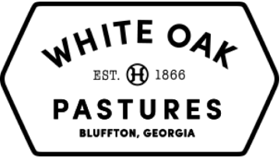
At White Oak Pastures we find that we often get to hear from friends, new and old, on a regular basis. Often we find that the email conversations have the potential to be something that our customers would be interested in. This is the case with the following conversation. Our own Will Harris, 4th generation owner of White Oak Pastures recently discussed methane emissions and the gastrointestinal health of cattle and its impact on the soil with our friend, Holly.
Conversations like this remind us of why we do what we do daily. We get the chance to work at improving our lives and communities.
Hi, Will,
I hope you are doing grand! Congratulations on publishing A Bold Return to Giving a Damn: One Farm, Six Generations, and the Future of Food!
Today, Anthony Suau (Organic Rising filmmaker) sent me some articles on the tremendous methane gas released into the atmosphere at CAFO farms. Reading the articles, I pondered on how you educated me on ruminant-stomach systems.
Back in the day, I recall you explaining how grass fed cattle retained their natural alkaline-based stomach systems. When feed was shifted to grain, the cattle-gastro systems became acidic and were breeding grounds for the E.coli strain harmful to humans. Thus, I wondered if the acidic-based-stomachs produced more methane than alkaline-based stomachs.
My research found that there was no difference in methane gas production since both digested the food in anaerobic conditions. Yet, I know that there must be an environmental impact related to changing the diet that an animal evolved to digest.
Note: I prefer to stay away from the overall inhumane conditions of CAFO farms, the carbon sequestration from ranch grasslands, the costs and impacts associated with the grain production, and the emissions from farm equipment. My focus is on the environmental impact of shifting from a cattle’s natural alkaline-based stomach system to an acidic-based system
My sense is you have answers to my inquiry off the top of your head and can point me in directions for supporting scientific research.
With Honor & Appreciation,
Holly
Hi, Holly-
It's good to hear from you. And you are asking an important question. I appreciate having the opportunity to bring some clarity to it.
Your recollection of the impact of the rumen's alkaline pH is correct, but that is not the most direct part of this environmental impact question. It does impact food safety, but that is a different topic.
You are correct that grain-fed cattle and grass-fed cattle both have anaerobic digestive tracts. But the similarity pretty much ends there.
Eating feed that has a very high percentage of grain is an unnatural diet for ruminant animals. In a more natural setting, the ruminant animal would consume a small quantity of mature seeds to ingest as they forage, but this would be a very low percentage of their daily uptake. Equally importantly, the grazing animal would be constantly moving. They would graze, urinate, and defecate on a different piece of land every day.
In a confinement feedlot, the percentage of grain in the diet is managed to maximize the daily weight gain of the animal to increase the profitability of the owner. In the confinement setting, an incredible amount of the animal's excrement is concentrated on a small piece of ground. This concentration kills the microbial life that should be naturally occurring in healthy soil.
This concentrated feeding program results in the development of an unnaturally obese creature that would never exist in a natural grazing environment. The meat is from a creature that is dying from the diseases of obesity and lack of exercise. These are issues that should be considered, but it does not address your methane question.
The answer to this question is that cattle should be constantly moved from paddock to paddock, grazing as they move, and also defecating and urinating as they move. The waste from these grazing animals would not contain subtherapeutic antibiotics that disrupt the microbial balance in the animal's rumen. These antibiotics are routinely fed to animals that are fed grain in confinement to keep them healthy and to increase their weight gain. The feces and urine from grazing animals also do not contain antibiotic residue that can adversely affect the microbes in the soil.
The soil's microbes and insects are not overwhelmed by the enormous quantities of waste that are dumped onto the land, as they would be where a feedlot sits. They are free to provide the contribution that they are meant to make...breaking the animal wastes down into beneficial organic matter that feeds the soil. That soil feeds the plants. That plant ultimately feeds the animal.
This Cycle of Nature is how the incredibly rich soils of the Great Plains and the Serengeti Plain were formed. And formed without the negative environmental impact that is caused by confinement feedlots.
Thank you for asking this important question. You may want to read Dirt To Soil by Gabe Brown. [Gabe is my best friend].
Come and visit the farm.
Will

